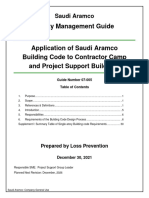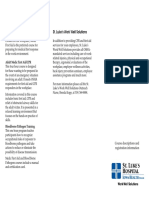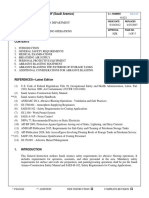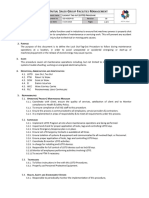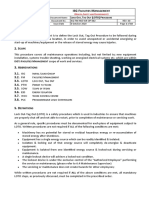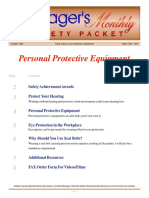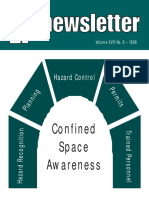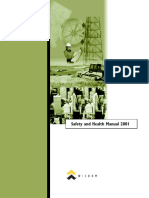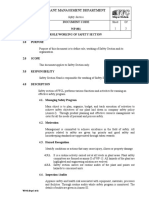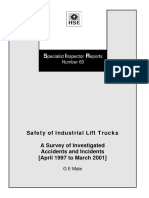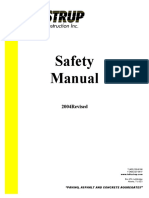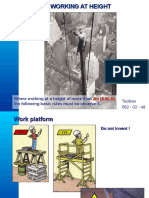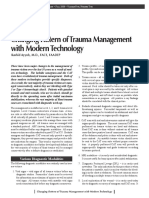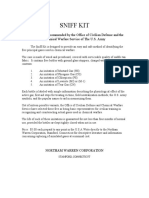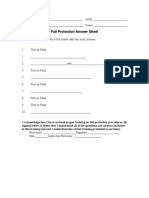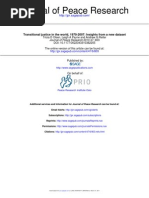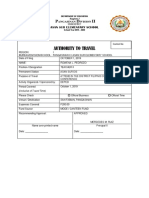Content:: Saudi Arabian Oil Company (Saudi Aramco) General Instruction Manual
Content:: Saudi Arabian Oil Company (Saudi Aramco) General Instruction Manual
Uploaded by
jhoniCopyright:
Available Formats
Content:: Saudi Arabian Oil Company (Saudi Aramco) General Instruction Manual
Content:: Saudi Arabian Oil Company (Saudi Aramco) General Instruction Manual
Uploaded by
jhoniOriginal Title
Copyright
Available Formats
Share this document
Did you find this document useful?
Is this content inappropriate?
Copyright:
Available Formats
Content:: Saudi Arabian Oil Company (Saudi Aramco) General Instruction Manual
Content:: Saudi Arabian Oil Company (Saudi Aramco) General Instruction Manual
Uploaded by
jhoniCopyright:
Available Formats
Saudi Aramco 7180 (5/89)
G.I. NUMBER Approved
6.012
SAUDI ARABIAN OIL COMPANY (Saudi Aramco)
GENERAL INSTRUCTION MANUAL ISSUE DATE REPLACES
ISSUING ORG. LOSS PREVENTION DEPARTMENT 6/2/1986 8/1977
SUBJECT: ISOLATION, LOCKOUT AND USE OF HOLD TAGS APPROVAL PAGE NUMBER
JJK 1 OF 4
CONTENT:
References
1 Purpose
2 Applicability
3 General Requirements
4 Procedures
5 Procedure for forceful removal of lockout devices
REFERENCES:
G.I. 2.100, "Work Permits".
Departmental instruction manuals (O.I.M's, T.I.M's, R.I.M's G.O.I.M's) pertaining to specific lockout
procedures.
1.0 PURPOSE:
The purpose of this instruction is to define minimum requirements for isolation, lockout and use of
hold tag procedures in Aramco. Alternative methods may be used if warranted, provided they meet or
exceed the minimum requirements in this instruction.
2.0 APPLICABILITY:
All Aramco departments shall apply this instruction in situations where equipment could be damaged
or personnel injured due to an unexpected release of energy or hazardous materials. Sources of energy
include mechanical, electrical, hydraulic and pneumatic systems. Examples of hazardous materials
include H2S or other toxic chemicals, hydrocarbons, hot water, and steam.
3.0 GENERAL REQUIREMENTS:
3.1 Whenever personnel work on or near equipment (electrical, fluid, mechanical or other) and
could be injured as a result of energy in the system, the equipment shall be isolated from its
energy sources. For fluid systems this could require the installation of blinds, the closure and
locking of valves, the removal of fluid from the system, or the physical removal of piping.
When working on electrical systems, switches, circuit breakers or other isolating devices could
be removed, locked in the safe position, or power supplies disconnected. Residual energy in
any system must be removed before work begins.
3.2 Operations or controlling organizations shall develop specific isolation, lock, and hold tag
procedures for their plants or operations and incorporate them into departmental Operations
* CHANGE ** ADDITION NEW INSTRUCTION COMPLETE REVISION X 4
Saudi Aramco 7180 (5/89)
G.I. NUMBER Approved
6.012
SAUDI ARABIAN OIL COMPANY (Saudi Aramco)
GENERAL INSTRUCTION MANUAL ISSUE DATE REPLACES
ISSUING ORG. LOSS PREVENTION DEPARTMENT 6/2/1986 8/1977
SUBJECT: ISOLATION, LOCKOUT AND USE OF HOLD TAGS APPROVAL PAGE NUMBER
JJK 2 OF 4
Instruction Manuals (OIM's). Departments may adopt this instruction as written if it will satisfy
their lock and hold tag requirements.
3.3 Operations and maintenance organizations and each department responsible for implementing
the lockout procedures per paragraph 3.2 shall train employees in all elements of the program.
3.4 Operations and maintenance organizations shall provide necessary lockout equipment to
employees.
4.0 PROCEDURES
4.1 Prior to commencing work, Operations shall identify isolating locations and types of isolating
devices required. If necessary, they shall consult with third parties, such as electrical specialists.
Equipment shall then be isolated and locks and tags installed by Operations.
4.1.1 Isolation will have been completed only when no associated control device, such as a
push button, control interlock or automatic start-up control circuit, shall have the capa-
bility of energizing equipment.
4.1.2 In situations where it is not possible to lockout or chain off an isolating device, isolation
may be accomplished by removal of fuses, disconnection of electrical cables, installation
of blind flanges, or physical removal of a component of the system supplying energy to
the equipment. The point of physical interruption should be identified with a fully com-
pleted tag.
4.1.3 When isolation has been completed (or before if appropriate), Operations will de-ener-
gize equipment to ensure that it contains no residual energy.
4.2 Other organizations or individuals working on equipment shall also install their locks and tags at
locations identified by Operations. Multiple lockout clips shall be used if necessary. Multiple
lockout clips, locks and tags are available in AMS, see appendix for AMS stock numbers.)
4.3 Each lock on a piece of equipment, or on a multiple lockout clip, must be able to be identified.
The preferred approach is to install a tag (Aramco Form 525) on each lock indicating plant
numbers or location, the date and time of lockout, name, badge number, organization, contact
phone and signature of the individual who installed the lock and the reason for the lock's
installation.
4.3.1 Each organization issuing locks shall have a system of uniquely identifying locks. The
preferred approach is to stamp or engrave locks appropriately.
4.3.2 Each lock shall be keyed separately, with no duplicate key, to ensure removal only by
the authorized user.
* CHANGE ** ADDITION NEW INSTRUCTION COMPLETE REVISION X 4
Saudi Aramco 7180 (5/89)
G.I. NUMBER Approved
6.012
SAUDI ARABIAN OIL COMPANY (Saudi Aramco)
GENERAL INSTRUCTION MANUAL ISSUE DATE REPLACES
ISSUING ORG. LOSS PREVENTION DEPARTMENT 6/2/1986 8/1977
SUBJECT: ISOLATION, LOCKOUT AND USE OF HOLD TAGS APPROVAL PAGE NUMBER
JJK 3 OF 4
4.4 Verification tests, in which all affected parties participate, shall be conducted by Operations on
each isolating device and on each piece of equipment isolated.
4.4.1 Each isolating device, such as a disconnect switch, shall be physically tested by moving
its operating mechanism against the padlock, multiple lockout clip, or chain, to confirm
that it cannot be operated.
4.5 When a craftsman leaves the job site temporarily, but intends to return to complete work, his
locks and tags may be left installed, provided this is acceptable to controlling organizations.
Operations may require craft locks and tags to be removed. Upon his return to work, the
employee shall verify his locks and tags are still in place ensuring the equipment is still isolated
prior to restarting his work.
4.6 When a craft shift change occurs and work is not complete, the oncoming shift may either:
4.6.1 Install their own locks and tags at locations where the previous shift had them - in which
case the off-going shift shall remove their tags and locks.
4.6.2 Effect a transfer of keys between shifts. This transfer requires the craft foremen or su-
pervisors to conduct a detailed review of installed locks and tags. Craft tags may be en-
dorsed by the oncoming shift or new tags may be installed.
4.7 When an operations shift change occurs, the oncoming supervisor shall review locations and
placement of isolated equipment, locks and tags. These operations tags and locks may be left
installed and do not require endorsement at each shift change. Keys to locks may be transferred
at the time the review is made.
4.8 When a craftsman completes his work, or leaves the job site permanently, his tags and lockout
devices shall be removed. The craft foreman or supervisor shall advise the Operations
Supervisor that the craftsman has completed his work and is removing his locks and tags.
4.9 Operations or controlling organizations shall always be the first to install a lock and tag on a
piece of equipment and the last to remove them. This lock and tag shall not be removed until
operations personnel have checked and examined equipment to ensure it can be safely
energized.
5.0 PROCEDURE FOR FORCEFUL REMOVAL OR CUTTING OF
LOCKOUT DEVICES AND PADLOCKS
5.1 No padlock/lockout device shall be cut or forcefully removed, without the permission of the
lock owner's superintendent, the operating shift superintendent or foreman.
5.1.1 (a) The operations department foreman or shift superintendent will attempt to contact
the individual who installed the lock, or his supervisor, to confirm that the employ-
* CHANGE ** ADDITION NEW INSTRUCTION COMPLETE REVISION X 4
Saudi Aramco 7180 (5/89)
G.I. NUMBER Approved
6.012
SAUDI ARABIAN OIL COMPANY (Saudi Aramco)
GENERAL INSTRUCTION MANUAL ISSUE DATE REPLACES
ISSUING ORG. LOSS PREVENTION DEPARTMENT 6/2/1986 8/1977
SUBJECT: ISOLATION, LOCKOUT AND USE OF HOLD TAGS APPROVAL PAGE NUMBER
JJK 4 OF 4
ee is safe and that the padlock can be removed.
(b) If the individual, his supervisor, or superintendent cannot be contacted, the shift
superintendent or foreman may remove the lock(s) and tag(s) only after
reviewing the equipment/process to be energized, to ensure that personnel and
facilities are safe from injury or damage.
5.1.2 The foreman or shift superintendent shall verbally advise the operations division super-
intendent of the action taken and record the removal of the lockout device in the opera-
tions log book. He will then document the incident in a written memo to the operations
division superintendent stating why the lockout device was removed, the original pur-
pose of the lockout device, and employees involved.
Recommended:
Manager, Loss Prevention Department
APPENDIX
ARAMCO FORM #525 AMS S/N 39-378-419
LOCK-OUT; MULTIPLE AMS S/N 21-350-487
LOCK AMS S/N 08-323-261
* CHANGE ** ADDITION NEW INSTRUCTION COMPLETE REVISION X 4
You might also like
- Sabic ExamDocument9 pagesSabic ExamSyed Ahmed manzoor100% (5)
- SMG 07-005 Application of Saudi Aramco Building Code To Contractors 2021-11-25Document38 pagesSMG 07-005 Application of Saudi Aramco Building Code To Contractors 2021-11-25baseet gazaliNo ratings yet
- G.I. 2.721 - Electrical Arc Flash Mitigation PDFDocument15 pagesG.I. 2.721 - Electrical Arc Flash Mitigation PDFJoypee Macasampon100% (6)
- ARAMCO Confined Space Entry BookletDocument44 pagesARAMCO Confined Space Entry BookletYogesh Dagar80% (5)
- 0002 - 100 Work Permit SystemDocument6 pages0002 - 100 Work Permit SystemOmar Santos86% (22)
- Aramco Safety QuestionDocument6 pagesAramco Safety QuestionJobHunters Teamup89% (9)
- Saudi Aramco LOTO GuideDocument8 pagesSaudi Aramco LOTO GuideMusharaf Shah100% (5)
- General Instruction Manual: Saudi Arabian Oil Company (Saudi Aramco)Document25 pagesGeneral Instruction Manual: Saudi Arabian Oil Company (Saudi Aramco)parijat pramanik100% (1)
- G.I. 6.003 - Incident Investigation PDFDocument11 pagesG.I. 6.003 - Incident Investigation PDFJoypee Macasampon50% (4)
- WEST BENGAL Pharma CompaniesDocument9 pagesWEST BENGAL Pharma CompaniesGanesh100% (2)
- GI 2.100 (2021) - Work Permit SystemDocument2 pagesGI 2.100 (2021) - Work Permit SystemAhmed RihanNo ratings yet
- GI 2.709 Gas Testing PDFDocument12 pagesGI 2.709 Gas Testing PDFMANI DEEP75% (4)
- FRCGuideDocument7 pagesFRCGuideHaleem Ur Rashid Bangash0% (1)
- General Instruction Manual: Saudi Arabian Oil Company (Saudi Aramco)Document25 pagesGeneral Instruction Manual: Saudi Arabian Oil Company (Saudi Aramco)Nasir IrfaniNo ratings yet
- Schedule D HSE RequirementDocument17 pagesSchedule D HSE RequirementEngr.Syed AmjadNo ratings yet
- Gi-7.025 Heavy Equipment Operator Testing and CertificationDocument1 pageGi-7.025 Heavy Equipment Operator Testing and CertificationAkbarShareef60% (5)
- Firewatch Trainning RevisedDocument3 pagesFirewatch Trainning RevisedZia ur Rehman100% (3)
- CSM - Contractor Site Administrative Requirements (CSAR) November 2019 RevisionsDocument6 pagesCSM - Contractor Site Administrative Requirements (CSAR) November 2019 RevisionsAkash K Nair100% (2)
- Gi 6.008 Restriction of Portable Electrical - ElectronicDocument5 pagesGi 6.008 Restriction of Portable Electrical - ElectronicAhmed ShoreemNo ratings yet
- G.I. 150.002 First Aid-CPR Training and First Aid KitsDocument5 pagesG.I. 150.002 First Aid-CPR Training and First Aid KitsAbdulwahid KhakiNo ratings yet
- 5 - CSM Written Exam (Ajith) - 2Document15 pages5 - CSM Written Exam (Ajith) - 2ali shah100% (1)
- 0006 007Document10 pages0006 007Genaro Paypa100% (4)
- Job Safety Analysis Work SheetDocument7 pagesJob Safety Analysis Work SheetTomNo ratings yet
- 0006 - 007-Reporting of Contractor On-Job Injuries Occupational Illnesses PDFDocument10 pages0006 - 007-Reporting of Contractor On-Job Injuries Occupational Illnesses PDFIssac JohnNo ratings yet
- Aramco GenDocument21 pagesAramco GenHaleem Ur Rashid Bangash0% (1)
- List of Saudi Aramco Approved Mark For Power AdaptorDocument1 pageList of Saudi Aramco Approved Mark For Power Adaptorjonathan camba75% (4)
- Questions For Safco InterviewDocument3 pagesQuestions For Safco InterviewYusuf Afraz100% (1)
- Saudi Arabian Oil Company (Saudi Aramco) General Instruction ManualDocument5 pagesSaudi Arabian Oil Company (Saudi Aramco) General Instruction ManualGeorge Zormpas100% (1)
- CPR, AED and First Aid CoursesDocument2 pagesCPR, AED and First Aid CoursesjhoniNo ratings yet
- Cover Letter TDDocument1 pageCover Letter TDmundaeg100% (1)
- WorkPermitReceiver PDFDocument2 pagesWorkPermitReceiver PDFAbu sufyan67% (3)
- General Information Saudi Aramco Work Permit ReceiverDocument4 pagesGeneral Information Saudi Aramco Work Permit Receiverjohn samuel100% (1)
- Gi-0006 030Document8 pagesGi-0006 030Ahmed Hassan Sabry0% (1)
- Saudi Arabian Oil Company (Saudi Aramco) General Instruction ManualDocument12 pagesSaudi Arabian Oil Company (Saudi Aramco) General Instruction ManualJoypee MacasamponNo ratings yet
- G.I. 151.006 Implementing Sanitary CodeDocument5 pagesG.I. 151.006 Implementing Sanitary Codebryan100% (5)
- WPR Q&a PDFDocument5 pagesWPR Q&a PDFAhtesham AlamNo ratings yet
- Aramco Safety Supervisor Written Exam Question and Answer Part 2Document8 pagesAramco Safety Supervisor Written Exam Question and Answer Part 2Er. Shamim Ansari100% (1)
- Schedule DDocument17 pagesSchedule DSIVA100% (4)
- General Instruction Gi 7 025Document9 pagesGeneral Instruction Gi 7 025mohamedNo ratings yet
- Gi-0006 005Document8 pagesGi-0006 005khrayzie bhoneNo ratings yet
- Issuing Organization Document No. Revision No. Effective Date Page NoDocument49 pagesIssuing Organization Document No. Revision No. Effective Date Page NoAnsarNo ratings yet
- G.I. 6.004 - Near Miss Reporting Process PDFDocument5 pagesG.I. 6.004 - Near Miss Reporting Process PDFJoypee MacasamponNo ratings yet
- Part I - 04 Work Permit SystemDocument7 pagesPart I - 04 Work Permit Systemsalah abddayem100% (1)
- Gi-2 104Document10 pagesGi-2 104ck19654840No ratings yet
- General Instruction Manual: ContentDocument13 pagesGeneral Instruction Manual: Contentck19654840No ratings yet
- 0006 - 005 RevDocument14 pages0006 - 005 RevDanilo de JurasNo ratings yet
- Ishaq CV 1Document4 pagesIshaq CV 1Muhammed ThanzeelNo ratings yet
- Saudi Aramco Work Permit Receiver Exam 4 Question & Answer Exam 2020Document11 pagesSaudi Aramco Work Permit Receiver Exam 4 Question & Answer Exam 2020Er. Shamim AnsariNo ratings yet
- Lock Out Tag Out: Review QuestionsDocument37 pagesLock Out Tag Out: Review QuestionsMansoor Ali100% (1)
- Part I - 02 Incident Reporting and InvestigationDocument2 pagesPart I - 02 Incident Reporting and InvestigationMuhammad RizwanNo ratings yet
- 0006 005 Reporting Investigation and Recording of Injuries Occupational Illnesses PDFDocument11 pages0006 005 Reporting Investigation and Recording of Injuries Occupational Illnesses PDFdan0427No ratings yet
- Aramco GuildlinesDocument25 pagesAramco GuildlinesQamar Khan100% (1)
- Aramco Exam Q&ADocument12 pagesAramco Exam Q&ASHAHBAZ ALAM100% (2)
- Aramco WPR Q & A 1Document14 pagesAramco WPR Q & A 1Mominul hoque33% (3)
- CSM by AramcoDocument3 pagesCSM by AramcoSharifullahNo ratings yet
- 0007 025Document9 pages0007 025Haleem Ur Rashid BangashNo ratings yet
- SABTANKDocument11 pagesSABTANKMd Arshad AlamNo ratings yet
- Saudi Arabian Oil Company (Saudi Aramco) : General Instruction ManualDocument5 pagesSaudi Arabian Oil Company (Saudi Aramco) : General Instruction ManualElie Aouad100% (2)
- Sling Inspection LogDocument1 pageSling Inspection LogSalman BankariNo ratings yet
- Saudi Aramco Work Permit Course Review With Important Question AnswersDocument6 pagesSaudi Aramco Work Permit Course Review With Important Question AnswersMoucha Justdoit100% (1)
- Contents:: Saudi Arabian Oil Company (Saudi Aramco) General Instruction ManualDocument4 pagesContents:: Saudi Arabian Oil Company (Saudi Aramco) General Instruction ManualSAQIB100% (1)
- ISG-HSEOP-06-LOTO (Lockout Tag Out Procedure)Document8 pagesISG-HSEOP-06-LOTO (Lockout Tag Out Procedure)Julio GregorioNo ratings yet
- ISG-FM-HSE-WR-OP-002-LOTO (Lockout Tagout) ProcedureDocument10 pagesISG-FM-HSE-WR-OP-002-LOTO (Lockout Tagout) ProcedureJulio GregorioNo ratings yet
- Hydrogen Sulfide: Volume XIX No. 1 - 1999Document6 pagesHydrogen Sulfide: Volume XIX No. 1 - 1999jhoniNo ratings yet
- Personal Protective Equipment: Safety Achievement Awards Protect Your HearingDocument14 pagesPersonal Protective Equipment: Safety Achievement Awards Protect Your HearingjhoniNo ratings yet
- Chemicals and Gases: Safety Achievement Awards Chemical Household ProductsDocument14 pagesChemicals and Gases: Safety Achievement Awards Chemical Household ProductsjhoniNo ratings yet
- Electrical Hazards: Safety Achievement Awards Top 10 Electrical Safety TipsDocument16 pagesElectrical Hazards: Safety Achievement Awards Top 10 Electrical Safety TipsjhoniNo ratings yet
- Hoist Safety: Plus: The Safe Choice Safety SecuredDocument6 pagesHoist Safety: Plus: The Safe Choice Safety SecuredjhoniNo ratings yet
- Chapter 5 Electrical Safety: TopicDocument7 pagesChapter 5 Electrical Safety: TopicjhoniNo ratings yet
- Fluor U&O Project Fall Protection and Working at Heights TrainingDocument68 pagesFluor U&O Project Fall Protection and Working at Heights TrainingjhoniNo ratings yet
- Confined Space Awareness: Hazard ControlDocument6 pagesConfined Space Awareness: Hazard ControljhoniNo ratings yet
- Safety and Health Manual 2001: Wisdom Solutions, LLC 2941 Winding Circle LILBURN, GA 30047Document136 pagesSafety and Health Manual 2001: Wisdom Solutions, LLC 2941 Winding Circle LILBURN, GA 30047jhoniNo ratings yet
- Safety Procedure ManualDocument15 pagesSafety Procedure ManualjhoniNo ratings yet
- Hot WorkDocument5 pagesHot WorkjhoniNo ratings yet
- Safety Procedure PDFDocument110 pagesSafety Procedure PDFjhoniNo ratings yet
- Sir 60Document59 pagesSir 60jhoniNo ratings yet
- Bites and Stings First AidDocument3 pagesBites and Stings First AidjhoniNo ratings yet
- Safety Manual: 2004revisedDocument120 pagesSafety Manual: 2004revisedjhoniNo ratings yet
- 062-02-48 Working at HeightDocument6 pages062-02-48 Working at HeightjhoniNo ratings yet
- Construction Fall ProtectionDocument43 pagesConstruction Fall ProtectionjhoniNo ratings yet
- FALL PROTECTION Slipstripsfalls - PpsDocument10 pagesFALL PROTECTION Slipstripsfalls - PpsjhoniNo ratings yet
- Fall Protection PanoramaDocument43 pagesFall Protection Panoramajhoni100% (1)
- Fall Protection Training Module 00Document25 pagesFall Protection Training Module 00jhoniNo ratings yet
- Changing Pattern of Trauma Management With Modern TechnologyDocument4 pagesChanging Pattern of Trauma Management With Modern TechnologyjhoniNo ratings yet
- Summary - MHFA - March - 08 PDFDocument7 pagesSummary - MHFA - March - 08 PDFjhoniNo ratings yet
- Fall Protection Quiz: Name: Date: Employee #: ProjectDocument1 pageFall Protection Quiz: Name: Date: Employee #: ProjectjhoniNo ratings yet
- Transcript Sniff PDFDocument1 pageTranscript Sniff PDFjhoniNo ratings yet
- SW Updates PDFDocument16 pagesSW Updates PDFjhoniNo ratings yet
- Fall Protection Answer SheetDocument1 pageFall Protection Answer SheetjhoniNo ratings yet
- New Instructor Application: MEDIC FIRST AID International, IncDocument2 pagesNew Instructor Application: MEDIC FIRST AID International, IncjhoniNo ratings yet
- Wfa ProductDocument14 pagesWfa ProductjhoniNo ratings yet
- Shore Health System: Administrative PolicyDocument3 pagesShore Health System: Administrative PolicyjhoniNo ratings yet
- JkiiiiiiiiiiDocument37 pagesJkiiiiiiiiiiMinhaj KhurshidNo ratings yet
- Feb. 28 Chicago Election ResultsDocument8 pagesFeb. 28 Chicago Election ResultsKelly BauerNo ratings yet
- Topline CBS Dems 8-4-15 PollDocument5 pagesTopline CBS Dems 8-4-15 PollCBS News PoliticsNo ratings yet
- Tacul Faculty and Staff ProfilesDocument2 pagesTacul Faculty and Staff ProfilesLembert CasinilloNo ratings yet
- NCR 2010 ResultsDocument1 pageNCR 2010 ResultsthepocnewsNo ratings yet
- Transitional Justice in The World Insights From A New DatasetDocument8 pagesTransitional Justice in The World Insights From A New DatasetAdriana Vladuti RudlingNo ratings yet
- Sentence Completion: AudioDocument15 pagesSentence Completion: AudioKiran ReddyNo ratings yet
- EY Conserving Value in A Maturing Russian Market 8 August 2013Document8 pagesEY Conserving Value in A Maturing Russian Market 8 August 2013Euglena VerdeNo ratings yet
- Worksheet Fight SongDocument2 pagesWorksheet Fight SongamandaNo ratings yet
- BBA III Year Complete Syllabus 1Document55 pagesBBA III Year Complete Syllabus 1Pranav PremlaniNo ratings yet
- Danbury Cases Defended by Rose KallorDocument2 pagesDanbury Cases Defended by Rose KallorJohn BerryNo ratings yet
- Brochure - 1 - DigitalDocument2 pagesBrochure - 1 - DigitalSajidNo ratings yet
- Linux Demilitarized Zone (DMZ) Ethernet Interface Requirements and ConfigurationDocument7 pagesLinux Demilitarized Zone (DMZ) Ethernet Interface Requirements and Configurationdonizete_souzaNo ratings yet
- 1сорDocument4 pages1сорУлпан ОмиртайNo ratings yet
- Trends, Issues and Policies in Philippine EducationDocument72 pagesTrends, Issues and Policies in Philippine EducationLezen Alle Liksap100% (1)
- Mini Project Ist Sem. WDocument55 pagesMini Project Ist Sem. WPRASHANT SARASWATNo ratings yet
- Circular - ICT Acceptable Use Agreement: Acknowledge The Agreement Attached Herewith (Page No.4)Document1 pageCircular - ICT Acceptable Use Agreement: Acknowledge The Agreement Attached Herewith (Page No.4)Baljeet KaurNo ratings yet
- Chapter 3Document4 pagesChapter 3iamarvindNo ratings yet
- Unit 3 Enhancing Reality TechnologyDocument3 pagesUnit 3 Enhancing Reality Technologyhồng quân trươngNo ratings yet
- Dana Resume 8Document3 pagesDana Resume 8danabearNo ratings yet
- Final ICAAP RISK APPETITE STRESS TEST 5th Sept 2024Document59 pagesFinal ICAAP RISK APPETITE STRESS TEST 5th Sept 2024Abhijeet Singh GangwaneaNo ratings yet
- Hamlet in The Cold War: Zbigniew Herbert's Elegy of Fortinbras' and Its ContextsDocument1 pageHamlet in The Cold War: Zbigniew Herbert's Elegy of Fortinbras' and Its ContextsANA LUIZA RIBEIRONo ratings yet
- Background Judaism Before The Arrival of MessiahDocument8 pagesBackground Judaism Before The Arrival of MessiahmhsbsasNo ratings yet
- Chennai CommissionerateDocument16 pagesChennai Commissioneratedcp5No ratings yet
- Cat 2003 Retest SolutionsDocument15 pagesCat 2003 Retest SolutionsRonak ChaudharyNo ratings yet
- Parenting Styles and Social Interaction of Senior Secondary School Students in Imo State, NigeriaDocument10 pagesParenting Styles and Social Interaction of Senior Secondary School Students in Imo State, NigeriaInternational Educational Applied Scientific Research Journal (IEASRJ)No ratings yet
- Short Story by Zaytsev P.SDocument8 pagesShort Story by Zaytsev P.SNegativeNo ratings yet
- Travel Order and Locator Slip 2Document2 pagesTravel Order and Locator Slip 2ZheroelObedozaLaguit100% (1)

